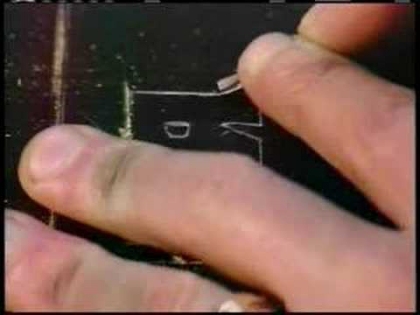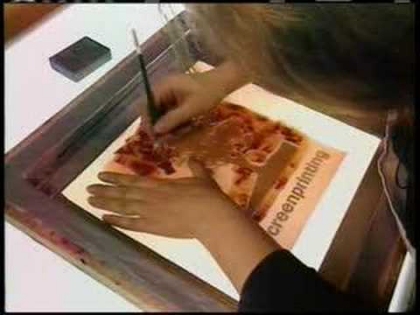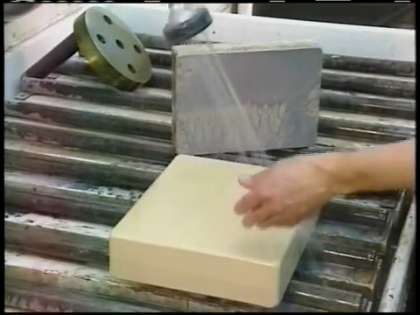Printmaking is an art medium that has grown in popularity within the last century. There are many forms of printmaking which range in complexity yet all forms are based on the same principle: transferring an image from a matrix onto a transferring base.
The printmaker draws, etches or carves an image onto a printing matrix - such as a stone or a metal plate. The matrix is then coated with ink, covered with a transferring base - such as paper or fabric - and then printed with a roller press or a hand press. The resulting print is often identical to the image first put onto the matrix.
Numerous copies can be made from one matrix. A printmaker may use this art medium for solely artistic purposes or for commercial productions. The fine art print is an original work of art in the same way a canvas or watercolour is an original work of art. The difference is that the print usually has a very small edition of the same image whereas the canvas or watercolour is one-of-a-kind. The fine art print tends to be produced in small numbers, ideally not exceeding an edition size of 100.
Techniques
Monoprint, Monotype Printing
The monotype or monoprint occupies a space between painting and the graphic arts, the proofs being a unique, and not an identical replica of an original picture.
But because these proofs are indirectly produced and printed on paper, and because an artist usually turns out an edition of several copies or versions of the same subject, monotypes are generally classified among the graphic arts. The print usually displays accidental effects, and only approximate results are expected in the making of duplicates.
The usual monotype is a painted on a rigid surface such as a metal plate, glass or plexi-glass using any convenient medium which does not dry too rapidly such as oil or watercolour paint. The painting is created freely or following a transferred outline drawing.
A damp sheet of paper is laid over the painting, held firmly with the fingers of one hand so that there is no lateral movement, and pressed to effect the transfer of the painting.
Embossing
Solid objects are laid on damp paper and put through the press, either at the same time as the plate or before hand. The impressions made in the paper by string, plant material, fabric, lace or other materials can make a unique design.
Relief or Block Printing
Relief Printing (Linoleum and Wood Cuts) is an old printing technique first used with wood and stone. Relief printing consists of carving and cutting areas of the printing matrix-wood, linoleum or stone - leaving a raised relief image.
The relief image is covered with ink which is applied in a thin coat with a roller. Paper is placed upon the inked matrix and the block is then printed using either a printing press or a hand printer.
Woodcuts
A woodcut is an impression made by inking a picture that has been cut on a flat surface of wood and pressing it on paper. The raised surface of the wood creates the image. The contours are usually angular and, if the picture is in black and white, the colour contrast is crisp. The grain and rings in the wood often spur on creativity, but the hardness of the medium often limits its sensitivity.
The woodcut is the most ancient of printing processes, appearing in Europe at the end of the fourteenth century. Towards the end of the middle ages broad sectors of the populace experienced an awakening interest in pictures and the acquisition of pictorial decorations. Woodcuts were sold in the markets and pasted on walls and doors, much as posters are used today.
Along with the practical use of woodcuts as a means of mass communication, emerged the more refined artistry of individual creative artists. The increased demand for their work led to the practice of employing technicians to execute the cutting and printing of patterns, the artists then producing only the designs.
Linoleum Printing (Linoblock)
Linoleum is composed of burlap coated with a heavy layer of linoxyn, which is made of polymerized oil mixed with ground cork and pigments. If desired, it may be mounted or purchased ready mounted on wooden blocks so that it may be taken by the printing press.
Etching
An etching is an impression taken from a metal plate on which a picture has been made by letting acid bite into the lines of a drawing. The lines are filled with ink and the image is created by the recessed areas, as pressure from a printing press forces the ink onto the paper.
The technique of etchings was developed in the Middle Ages as a method of decorating weapons and was first used for printing on paper in Germany in the early sixteenth century. The earliest etchings were made on steel or iron. Later copper was used, and today, often zinc.
The metal plate is coated with a thin layer of wax-like substance, called the ground, which is impervious to acid. The design is made through the ground with a sharp, needle-like instrument, laying the metal bare. When the design is completed, the plate is placed in a bath of acid diluted with water. The acid then eats into the plate along the lines drawn.
Various tones are achieved by skillful timing in the acid bath. Drawing is done with freedom and ease because the etching ground offers little resistance to the artist's needle. The softness of etched lines is a result of the uneven action of the acid on the granular structure of the metal.
Serigraphy
Serigraphy or silk-screen printing is a printmaking process fairly new to artists, yet it has long been a standard procedure used by commercial industries to decorate textiles and multicoloured posters. The exact origin of silk-screen printing is not known, however its oldest related forerunner is a certain type of Japanese stencil.
The term serigraphy was proposed by Carl Zigrosser as a designation for an artist made silk-screen print in order to distinguish it from silk-screen work that was executed on an industrial or reproductive basis.
Serigraph printing is basically a stencil process, where the designs are placed upon a piece of fine mesh screen-like material tacked to a wooden frame, with various film forming materials being used as surface barriers.
A coloured ink is poured into the frame; the frame is placed in contact with the surface to be printed upon, and the colour is scraped over the stencil with a rubber squeegee and deposited upon the paper or other ground through the mesh of the uncoated areas of the screen.
Because of its simplicity in process and execution, serigraph printing has become a popular form of printing, allowing artists to create multiple productions.
Lithography
Lithography was invented in Munich in 1798 by Aloys Senefelder and has since become a widely used artistic medium. Lithography is classified as planographic or a flat-surface process, as distinguished from other graphic arts processes, which are either intaglio or relief.
The process consists of drawing or painting with greasy crayons and inks on a particular species of limestone which has been ground down to the desired texture.
After many chemical processes, the stone is moistened with water, whereupon the parts not covered by the crayon become wet, while the areas where the greasy drawing was made repel the water and remain dry. An oily ink is then applied with a roller; it adheres only to the drawing and is repelled by the wet parts of the stone.
Paper is then placed upon the stone and placed under a press producing an exact reversed copy of the image on the stone. The direct manner in which the drawing is made and the range of tones that can be obtained, make the process popular.
Intaglio
The term intaglio comes from the Italian word itagliare, which means to engrave, carve or cut. This encompasses several printmaking methods such as aquatint, drypoint, mezzotint, embossing, etching and engraving, all of which involve the incision of designs into plates.
The general premise is to work from a plate of copper, zinc, or cardboard, creating incised lines that can be printed. Once the plate is worked in the desired method, a layer of ink is applied to the plate. The lines and crevices will hold the ink and the surface of the plate is then wiped clean. Additional colours may be rolled on the surface before printing.
Dampened paper is then placed over the inked plate and both are run through the etching press. The pressure must be enough for the paper to be pushed into the lines to pick up the ink. The paper is carefully lifted from the plate and the impression left on the paper is the original print.
Aquatint
Aquatint is a technique used to produce tones of varying densities using a series of dots. The plate is covered with droplets of powdered rosin or lacquer and these droplets protect the plate when it is placed in the acid. The area around the droplets will be bitten by the acid, resulting in a tonal effect when printed.
Drypoint
A needle is used to scratch lines into the metal plate. The burr of the metal remains on the plate and catches ink, giving the print a ragged, soft line. When printed, the effect is rather like a pencil drawing.
Mezzotint
This technique is achieved by pressing a curved, serrated, mezzotint rocker over the surface of a copper plate to produce a roughened surface. The pattern is made by the rocker and gives the print deep, soft black areas. Tonal gradations are achieved by scratching off the burr in certain areas. Highlights are created by burnishing the surface smooth.
Engraving
A hard steel burin is used to cut into a copper or zinc plate resulting in a hard and distinct line. The deeper the lines are cut, the darker they will come out in the print. Shadow and tonal effects are obtained by varying the distance between lines, crosshatching and dot patterns.
When an uninked plate is run through the press with dampened paper, the impression will be an embossed image. The recessed lines of the plate cause a raised line in the print.
Etching
An acid proof ground of asphaltum is applied to a metal plate. The artist draws on the asphaltum exposing the metal as the asphaltum is scratched off. The plate is then immersed in an acid bath. The exposed areas will be bitten by the acid while the other areas are protected. The quality of the line depends on the strength of the acid and the length of time it is left in the acid bath.
Photo Etching
A plate is covered with a light sensitive emulsion. A transparent positive of the image on high contrast film is then placed, emulsion side down, on the plate. The next step is to expose the emulsion. For this procedure a light source with ultraviolet content is necessary.
After exposure the plate is washed and the areas of the plate covered by the positive areas of the image are not hardened and will wash away. This leaves the non-image areas covered with the hardening solution that is acid resisting. The plate is then etched and printed as a normal intaglio plate.
Printmaking and Collage
The French term collage is the standard name for the technique of making areas of paper, cardboard, fabrics, etc. adhere to a flat surface as elements of a design or picture.
When objects that are more or less two-dimensional, such as printed paper items, and are pasted to a flat surface, the work can be called a collage.
Chine Colle
Chine Colle is a method of pasting paper to the original sheet of printing paper that is used on a plate or block. A variety of papers can be applied, including tissue paper and transparent Oriental papers which are available in variety of colours and patterns. The paper can remain as a whole sheet, or can be torn into pieces overlaying the original print sheet.
The wood block, lino-cut, lithograph or etched plate is inked and then laid on the bed at the press. The tissue paper is then laid carefully on the design and then a very finely diluted paste or cellulose glue is brushed on gently. Before the paste dries the main heavy sheet of paper is laid over this.
The sheet can also have a thin layer of paste or it can be damp. The thin paper adheres to the heavy one as it is run through the press. The results can be very textural, with layers of transparent colours adding a new dimension to the design. Acid free paper and neutral PH pastes should be used to acquire even bonding and drying.
Collagraph
The collagraph takes its name from the word collage.
A collagraph plate is a collage of various techniques and materials that are assembled to print as line and texture.
The plate is developed by gluing or painting textured materials onto a thin, flat base material such as masonite board. A variety of found objects can be arranged into a collage and glued to the plate using white glue or an acrylic matte medium. The matte medium is brushed over the plate, sealing in the objects for printing.
Once the plate has been inked a tarlatan (similar to hardened cheese-cloth fabric) is wiped over the plate. One must decide the desired amount of gradation of colour, due to the multilayered surface.
Foam Relief Printing
Like all relief printing, a plate is prepared into which a design of lines have been incised by the artist.
The flat surface of the plate is rolled with ink and a fine, smooth piece of paper is placed on top of the inked plate.
Pressure is applied by the artist to the back of the paper. This transfers the inked image from the plate onto the paper.
The artist then pulls the paper from the plate producing an original print.
This can be done a limited number of times depending on the stability of the plate. The plate is then destroyed.
In the case of foam relief printing, the plate is made from recycled foam trays, which are very easily incised or cut up for jig-saw prints. By their nature these plates are very fragile and a very limited edition of original prints can be pulled.
Text provided by the Art Gallery of Peel, videos from the Minneapolis Institute of Arts.

 Visual Arts Brampton
Visual Arts Brampton



